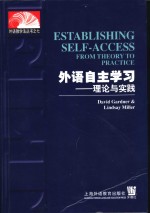

外语自主学习 理论与实践 英文本PDF电子书下载
- 电子书积分:11 积分如何计算积分?
- 作 者:(英)DavidGardner,(英)LindsayMiller著
- 出 版 社:上海:上海外语教育出版社
- 出版年份:2002
- ISBN:7810806181
- 页数:276 页
PART 1 THEORETICAL PERSPECTIVES 5
1 Background to self-access language learning 5
1.1 Introduction 5
1.2 Definitions 5
1.3 Elements of self-access 8
1.4 Issues in establishing self-access 11
1.5 SALL environments 20
1.6 Justifying SALL 20
1.7 The costs of SAIL 31
1.8 Summary 34
1.9 Tasks 35
1.1O For discussion 36
2 Learners and teachers beliefs and attitudes about language learning 37
2.1 Introduction 37
2.2 Learners beliefs about language learning 37
2.3 Teachers beliefs about language learning 38
2.4 Differences between learners and teachers beliefs about language learning 40
2.5 Cultural influences 42
2.6 Preparing learners for self-access language learning 43
2.7 Preparing teachers for self-access language learning 43
2.8 Learners and teachers beliefs about self-access language learning 47
2.9 Summary 49
2.10 Tasks 50
2.11 For discussion 50
3 A typology of self-access 51
3.1 Introduction 51
3.2 Types of self-access facilities 52
3.3 Learner support structures 57
3.4 Aself-access typology 57
3.5 Self-access system flexibility 58
3.6 Summary 64
3.7 Tasks 64
3.8 For discussion 64
4.1 Introduction 65
4 Management of self-access facilities 65
4.2 Defining management 66
4.3 Approaches to management 69
4.4 Managinga self-access centre 71
4.5 Managing classroom self-access 77
4.6 Involving learners 77
4.7 Training managers 78
4.8 Evaluation 80
4.11 For discussion 82
4.9 Summary 82
4.10 Tasks 82
PART 2 PRACTICAL PERSPECTIVES 83
5 Learner profiles 83
5.1 Introduction 83
5.2 A definition of a learner profile 84
5.3 The goals of using learner profiles 84
5.4 The benefits to learners 86
5.5 The benefits to teachers 87
5.6 What a learner profile looks like 88
5.7 Constructing learner profiles 88
5.8 Updating profiles 93
5.9 Access to information 94
5.10 Summary 94
5.11 Tasks 95
5.12 For discussion 95
6.1 Introduction 96
6 Materials for self-access language learning 96
6.2 Published language-learning materials 97
6.3 Authentic materials 101
6.4 Specially produced materials 105
6.5 Student contributions to materials 107
6.6 A note about generic materials 109
6.7 Stocking a self-access centre 113
6.8 Knowing how good your materials are 113
6.9 Implications for self-access materials development 114
6.10 Summary 121
6.11 Tasks 122
6.12 For discussion 122
7 Self-access activities 123
7.1 Introduction 123
7.2 Getting started 123
7.3 Ideas for self-access activities 129
7.4 General activities in a self-access centre 136
7.7 For discussion 138
7.6 Tasks 138
7.5 Summary 138
8 Physical settings and resourcing 139
8.1 Introduction 139
8.2 The classroom 139
8.3 Library 143
8.4 Self-access centres 145
8.5 Summary 154
8.7 For discussion 155
8.6 Tasks 155
9 From teacher-directed to self-access learning 156
9.1 Introduction 156
9.2 Getting started in self-access learning 157
9.3 Designing and implementing self-access learning 163
9.4 Reflecting on self-access 174
9.5 Summary 178
9.6 Tasks 178
9.7 For discussion 178
10 Counselling 180
10.1 Introduction 180
10.2 Classroom teachers and self-access counsellors 180
10.3 Managing counsellors 183
10.4 Practical skills for working in a SAC 186
10.5 Counsellor training 188
10.6 Effective counselling 193
10.7 Non-counselling duties 194
10.8 Alternative counselling 196
10.9 Summary 201
10.10 Tasks 203
10.11 For discussion 203
11 Assessment in self-access learning 205
11.1 Introduction 205
11.2 Purposes of assessment 205
11.3 Kinds of assessment 206
11.4 The content of assessments 216
11.5 The administration of assessments 220
11.6 Using the results of assessments 222
11.7 Summary 223
11.8 Tasks 224
11.9 For discussion 224
12 Evaluation of self-access language learning 225
12.1 Introduction 225
12.2 Reasons for evaluating self-access learning 226
12.3 Measuring efficiency and effectiveness 228
12.4 The focus and effect of evaluations 232
12.5 Deciding what to evaluate 233
12.6 Matching evaluations to self-access goals 233
12.7 Evaluation tools 236
12.8 Sources of data 237
12.9 A step-by-step guide to conducting an evaluation of self-access 238
12.10 Summary 238
12.12 For discussion 240
12.11 Tasks 240
PART 3 CASE STUDIES 241
13 Introduction 241
14 Case study 1: Self-access in a primary school 242
15 Case study 2: Self-access in a secondary school 247
16 Case study 3: Self-access in a university 252
17 Case study 4: Self-access in a private language school 257
References 262
Index 272
- 《SQL与关系数据库理论》(美)戴特(C.J.Date) 2019
- 《联吡啶基钌光敏染料的结构与性能的理论研究》李明霞 2019
- 《情报学 服务国家安全与发展的现代情报理论》赵冰峰著 2018
- 《英汉翻译理论的多维阐释及应用剖析》常瑞娟著 2019
- 《新课标背景下英语教学理论与教学活动研究》应丽君 2018
- 《党员干部理论学习培训教材 理论热点问题党员干部学习辅导》(中国)胡磊 2018
- 《虚拟流域环境理论技术研究与应用》冶运涛蒋云钟梁犁丽曹引等编著 2019
- 《当代翻译美学的理论诠释与应用解读》宁建庚著 2019
- 《语文教育教学实践探索》陈德收 2018
- 《彼得·布鲁克导演实践研究》邓小玲著 2019
- 《古代巴比伦》(英)莱昂纳德·W.金著 2019
- 《BBC人体如何工作》(英)爱丽丝.罗伯茨 2019
- 《一个数学家的辩白》(英)哈代(G.H.Hardy)著;李文林,戴宗铎,高嵘译 2019
- 《莎士比亚全集 2》(英)莎士比亚著,朱生豪等译 2002
- 《莎士比亚戏剧精选集》(英)威廉·莎士比亚(William Shakespeare)著 2020
- 《莎士比亚 叙事诗·抒情诗·戏剧》(英)威廉·莎士比亚著 2019
- 《亚历山大继业者战争 上 将领与战役》(英)鲍勃·本尼特,(英)麦克·罗伯茨著;张晓媛译 2019
- 《孩子们的音乐之旅 1 宝宝睡觉 幼儿版》包菊英主编 2016
- 《超级参与者》王金强责编;赵磊译者;(澳)杰里米·海曼斯,(英)亨利·蒂姆斯 2020
- 《物联网导论》张翼英主编 2020
- 《培智学校义务教育实验教科书教师教学用书 生活适应 二年级 上》人民教育出版社,课程教材研究所,特殊教育课程教材研究中心编著 2019
- 《习近平总书记教育重要论述讲义》本书编写组 2020
- 《办好人民满意的教育 全国教育满意度调查报告》(中国)中国教育科学研究院 2019
- 《教育学考研应试宝典》徐影主编 2019
- 《语文教育教学实践探索》陈德收 2018
- 《家庭音乐素养教育》刘畅 2018
- 《学前教育学》王换成主编 2019
- 《近代体育游戏教育史料汇编 第1辑 1》王强主编 2016
- 《全国学前教育专业(新课程标准)“十三五”规划教材 简谱手风琴教程 第2版》(中国)杨克勤,王宝庆 2019
- 《现代教育技术》李志河主编 2019
